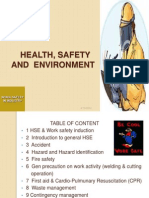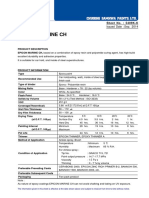Evidence-Based Prevention of CINV: What's New in ASCO Guidelines?
Evidence-Based Prevention of CINV: What's New in ASCO Guidelines?
Uploaded by
robyalfCopyright:
Available Formats
Evidence-Based Prevention of CINV: What's New in ASCO Guidelines?
Evidence-Based Prevention of CINV: What's New in ASCO Guidelines?
Uploaded by
robyalfOriginal Title
Copyright
Available Formats
Share this document
Did you find this document useful?
Is this content inappropriate?
Copyright:
Available Formats
Evidence-Based Prevention of CINV: What's New in ASCO Guidelines?
Evidence-Based Prevention of CINV: What's New in ASCO Guidelines?
Uploaded by
robyalfCopyright:
Available Formats
E M E S I S
hours after chemotherapy were observed
Evidence-Based Prevention of CINV: in 50.8% of the aprepitant group and
What’s New in ASCO Guidelines? 42.5% of the standard treatment group,
yielding a significant difference of 8.3%
(P = 0.015). The team reported that
S
ince the publication of the initial Dr. Hesketh first reviewed the risk 75.7% and 57.7% of patients, respec-
American Society of Clinical On- for CINV, noting that the most predic- tively, experienced no vomiting 0–120
cology (ASCO) antiemetic guide- tive patient-related factors of the condi- hours after chemotherapy, representing
lines in 1999, significant clinical devel- tion are young age, female gender, prior a 17% difference (P < 0.001).
opments have necessitated revision of chemotherapy (especially when emesis “The magnitude of the aprepitant
recommendations for preventing che- occurred), and low or no chronic intake benefit with AC was less than with a
motherapy-induced nausea and vomit- of alcoholic beverages. Polymorphisms cisplatin-based regimen,” Dr. Hesketh
ing (CINV). This new information was pertaining to neurotransmitter receptors noted. “Aprepitant improved control,
summarized by Paul J. Hesketh, MD, and the metabolism of antiemetics also though less robustly.”
Professor of Medicine, Tufts University may be important. Based on these studies, ASCO up-
School of Medicine, and Chief, Division The most predictive treatment-relat- dated its guidelines to recommend use
of Hematology and Oncology, Caritas ed factor is the emetogenicity of chemo- of a 5-HT3 antagonist, dexamethasone,
St. Elizabeth’s Medical Center, Boston, therapy. Attendees of the 2004 Perugia and aprepitant to prevent acute CINV;
Massachusetts. International Antiemetic Consensus this applies to patients receiving highly
CINV is one of the most feared side Conference changed the emetogenic po- emetogenic chemotherapy or AC. For
effects of chemotherapy. When inad- tential of antineoplastic agents from the patients receiving highly emetogenic
equately controlled, it adds to the mor- original five-level Hesketh model into chemotherapy, a two-drug regimen of
bidity and cost of therapy and impairs a four-level schema (Table 1) that now aprepitant plus dexamethasone is recom-
quality of life. The main clinical syn- is promoted by ASCO. “I recommend mended for preventing delayed CINV.
dromes are acute CINV (which occurs these for your institutional guidelines,” The approach to preventing delayed
within 24 hours of chemotherapy) and Dr. Hesketh told attendees. emesis has been modified from ASCO’s
delayed CINV (which occurs at least 24 The development of aprepitant, a 1999 guidelines, which advised giving
hours after dosing). Effective prophy- drug that selectively antagonizes the dexamethasone plus either metoclo-
laxis has made anticipatory CINV only binding of substance P to the neuroki- pramide or a 5-HT3 antagonist after high-
a minor problem. nin-1 receptor, was significant to CINV ly emetogenic chemotherapy. Since 1999,
The highly emetogenic nature of prevention; given at 125 mg orally on day three large trials enrolling over 1,200 pa-
cisplatin, which “universally” causes 1 and then 80 mg orally on days 2 and tients compared granisetron (Kytril) or
CINV, led to the development of better 3, aprepitant and its role against CINV ondansetron plus dexamethasone with
antiemetic agents. The efficacy of the 5- were defined in the ASCO update. dexamethasone alone; the results of all
hydroxytryptamine-3 (5-HT3; serotonin) In phase III studies, at least 20% of three showed that the combination was
antagonists and the neurokinin-1 antag- patients receiving highly emetogenic che- not superior to dexamethasone mono-
onist aprepitant (Emend) now may pre- motherapy were completely free of emesis therapy. The ASCO Update Commit-
vent CINV completely in at least 70% if they received aprepitant, representing a tee, therefore, no longer recommends the
of patients receiving highly emetogenic drop in relative risk of almost 50%. combination of a 5-HT3 antagonist plus
chemotherapy, Dr. Hesketh noted. A more recent study in breast cancer dexamethasone in this setting. Further,
patients receiving an anthracycline plus noted Dr. Hesketh, metoclopramide’s
Changing the Guidelines cyclophosphamide (AC; Warr DG et al. role in preventing delayed emesis has
The updated ASCO guidelines (Kris J Clin Oncol 2005;23:2822–2830) com- been supplanted by aprepitant.
MG et al. J Clin Oncol 2006;24:2932– pared standard prophylaxis (ie, 8 mg of
2947) included a new emetogenic classifi- ondansetron twice daily plus 20 mg of Role of Palonosetron
cation schema, described the integration dexamethasone on day 1, followed by 8 Palonosetron is an active, safe, new
of aprepitant into antiemetic manage- mg of ondansetron twice daily on days 5-HT3 antagonist that differs from oth-
ment, noted the addition of a new 5-HT3 2 and 3) with a regimen that included er agents in this class in a number of
antagonist palonosetron (Aloxi), and de- aprepitant (ie, 8 mg of ondansetron twice ways. It has a prolonged half-life (~ 40
fined the role of serotonin antagonists in daily plus 12 mg of dexamethasone on hours) and offers enhanced receptor
delayed emesis that is induced by highly day 1 followed by 80 mg of aprepitant on binding affinity (30-fold) when com-
emetogenic chemotherapy. days 2 and 3). Complete responses 0–120 pared with agents developed earlier.
VOLUME 6, NUMBER 2 ■ FEBRUARY 2008 www.SupportiveOncology.net 71
E M E S I S
The dose of palonosetron approved by
the US Food and Drug Administration Table 1
is 0.25 mg intravenously (IV) before Modified Hesketh Classification of Emetic Risk
chemotherapy. of Intravenous Antineoplastic Agents
Clear-cut superiority of palonose- EMETIC RISK (ESTIMATED
tron over first-generation agents has INCIDENCE WITHOUT PROPHYLAXIS) ANTINEOPLASTIC AGENT
not been defined; however, three large, High (> 90%) Carmustine
multicenter trials with multiple cycle Cisplatin
Cyclophosphamide (≥ 1,500 mg2)
extensions showed the drug’s benefit Dacarbazine
against the effects of highly and mod- Mechlorethamine
erately emetogenic chemotherapy. Ru- Streptozocin
benstein et al (Proc Am Soc Clin On- Moderate (30%–90%) Carboplatin
col 22;2003:2932) compared 0.25 mg Cyclophosphamide (< 1,500 mg2)
Cytarabine (> 1 g/m2)
and 0.75 mg of palonosetron IV with Daunorubicin
32 mg of ondansetron IV and 100 mg Doxorubicin
of dolasetron (Anzemet) IV, all given Epirubicin
as single doses on day 1; both palo- Idarubicin
Ifosfamide
nosetron doses produced numerically Irinotecan
better outcomes in terms of complete Oxaliplatin
responses. Low (10%–30%) Bortezomib
Palonosetron outperformed ondan- Cetuximab
Cytarabine (≤ 100 mg/m2)
setron and dolasetron in a number of Docetaxel
parameters, yet the absence of prospec- Etoposide
tive trials specifically designed to prove 5-Fluorouracil
the superiority of palonosetron over Gemcitabine
Methotrexate
first-generation 5-HT3 antagonists re- Mitomycin
sulted in the ASCO Update Committee Mitoxantrone
not recommending use of a preferred 5- Paclitaxel
HT3 antagonist. Pemetrexed
Topotecan
“The palonosetron trials were not Trastuzumab
designed to show superiority,” noted Dr. Minimal (< 10%) Bevacizumab
Hesketh. “The data are not compelling Bleomycin
enough to argue for a preferred agent at Busulfan
2-Chlorodeoxyadenosine
this time. If palonosetron proves superior
Fludarabine
to regimens incorporating corticosteroids Rituximab
and using multiple-day schedules for the Vinblastine
first-generation 5-HT3 antagonists, the Vincristine
Vinorelbine
recommendation would then change.
Reprinted with permission of Oxford University Press (Roila et al. Ann Oncol 2006;17:20–28)
Until then, we can’t recommend a spe-
cific 5-HT3 antagonist.”
Limitations of Guidelines
More research is needed to answer Additionally, published data with apre- erately emetogenic agents (eg, oxalipla-
several questions. For example, none pitant are limited to the setting of cispla- tin [Eloxatin], irinotecan [Camptosar]),
of the current guidelines, including the tin and AC; its potential role with other which weakens the strength of current
ASCO Update, addresses the issue of moderately emetogenic chemotherapeu- antiemetic treatment recommendations.
oral chemotherapy agents and the need tic agents is undefined. “We, therefore, do “The emetogenic potential of many new-
for prophylaxis in this setting. “Guide- not yet know how to integrate aprepitant er agents is based mainly on opinion,”
lines were predicated on intravenously in other settings,” he added. Dr. Hesketh commented, “so we made
administered chemotherapy agents. We Finally, emetogenic potential, es- recommendations broadly applicable to
have not addressed this topic yet, be- pecially for delayed emesis, is poorly agents in the same class, based on our
cause data are still lacking,” he said. characterized for many highly and mod- best guess.”
72 www.SupportiveOncology.net THE JOURNAL OF SUPPORTIVE ONCOLOGY
You might also like
- Rangers of Shadow Deep - Supplement - Adventure Compendium I88% (8)Rangers of Shadow Deep - Supplement - Adventure Compendium I206 pages
- Case-Based Learning Nausea and Vomiting: Sang Ayu Putu Wahyu Pratiwi NIM. 2208612048No ratings yetCase-Based Learning Nausea and Vomiting: Sang Ayu Putu Wahyu Pratiwi NIM. 22086120488 pages
- Chemotherapy-Induced Acute Emesis: ObjectivesNo ratings yetChemotherapy-Induced Acute Emesis: Objectives2 pages
- Antiemetics . Cinv . The Oncologist's NightmareNo ratings yetAntiemetics . Cinv . The Oncologist's Nightmare43 pages
- Pemetrexed Fresenius Kabi Epar Product Information enNo ratings yetPemetrexed Fresenius Kabi Epar Product Information en64 pages
- 2014-Effects and Mechanisms of Transcutaneous Electroacupuncture On Chemotherapy Induced Nausea and VomitingNo ratings yet2014-Effects and Mechanisms of Transcutaneous Electroacupuncture On Chemotherapy Induced Nausea and Vomiting6 pages
- Is Granisetron-Dexamethasone Combination Better ThanNo ratings yetIs Granisetron-Dexamethasone Combination Better Than8 pages
- Evidence-Based Treatmentsin Pemphigusvulgaris Andpemphigus FoliaceusNo ratings yetEvidence-Based Treatmentsin Pemphigusvulgaris Andpemphigus Foliaceus8 pages
- Proposal For The Inclusion of Anti-Emetic Medications (For Children) in The Who Model List of Essential MedicinesNo ratings yetProposal For The Inclusion of Anti-Emetic Medications (For Children) in The Who Model List of Essential Medicines44 pages
- Antiemetic Use For Nausea and Vomiting in Adult Emergency 2No ratings yetAntiemetic Use For Nausea and Vomiting in Adult Emergency 28 pages
- Mepolizumab For Prednisone-Dependent Asthma With Sputum EosinophiliaNo ratings yetMepolizumab For Prednisone-Dependent Asthma With Sputum Eosinophilia9 pages
- NURS 2500 Learning Guide Week 3 - Pharmacology1No ratings yetNURS 2500 Learning Guide Week 3 - Pharmacology17 pages
- Lulu Hasna - PPT Journal Reading AnesthesiaNo ratings yetLulu Hasna - PPT Journal Reading Anesthesia11 pages
- Effect of Intrathecally Administered Ketamine, Morphine, and Their Combination Added To Bupivacaine in Patients Undergoing Major Abdominal Cancer Surgery A Randomized, Double-Blind StudyNo ratings yetEffect of Intrathecally Administered Ketamine, Morphine, and Their Combination Added To Bupivacaine in Patients Undergoing Major Abdominal Cancer Surgery A Randomized, Double-Blind Study8 pages
- Key Updates in The Clinical Application of Electroconvulsive Therapy-2017No ratings yetKey Updates in The Clinical Application of Electroconvulsive Therapy-201710 pages
- Cenobamate for the treatment of focal epilepsiesNo ratings yetCenobamate for the treatment of focal epilepsies10 pages
- Biologic Treatments in Takayasu's Arteritis: A Comparative Study of Tumor Necrosis Factor Inhibitors and TocilizumabNo ratings yetBiologic Treatments in Takayasu's Arteritis: A Comparative Study of Tumor Necrosis Factor Inhibitors and Tocilizumab16 pages
- Annex I Summary of Product CharacteristicsNo ratings yetAnnex I Summary of Product Characteristics83 pages
- Antidepressant Drugs: Different, Yet The Same - The Presently Available Antidepressants Vary Across andNo ratings yetAntidepressant Drugs: Different, Yet The Same - The Presently Available Antidepressants Vary Across and5 pages
- 185852-Article Text-472571-1-10-20190423 PDFNo ratings yet185852-Article Text-472571-1-10-20190423 PDF9 pages
- Corticosteroids For Elderly Patients With Breast CancerNo ratings yetCorticosteroids For Elderly Patients With Breast Cancer5 pages
- The Prophylactic Effect of Timing of DexNo ratings yetThe Prophylactic Effect of Timing of Dex8 pages
- Increased Postoperative Opioid Consumption in the Presence of Coadministration of 5-Hydroxytryptamine Type 3 Antagonists with Acetaminophen_ A Hospital Registry StudyNo ratings yetIncreased Postoperative Opioid Consumption in the Presence of Coadministration of 5-Hydroxytryptamine Type 3 Antagonists with Acetaminophen_ A Hospital Registry Study12 pages
- Interactions Between Mivacurium and Atracurium: British Journal of Anaesthesia 1994 73: 484 - 189No ratings yetInteractions Between Mivacurium and Atracurium: British Journal of Anaesthesia 1994 73: 484 - 1896 pages
- Acetaminophen Poisoning An Evidence Based Consensus Guideline For Out of Hospital ManagementNo ratings yetAcetaminophen Poisoning An Evidence Based Consensus Guideline For Out of Hospital Management19 pages
- Mycophenolate Mofetil Versus Azathioprine in The Maintenance Therapy of Lupus NephritisNo ratings yetMycophenolate Mofetil Versus Azathioprine in The Maintenance Therapy of Lupus Nephritis6 pages
- COPD: Guidelines Update and Newer TherapiesNo ratings yetCOPD: Guidelines Update and Newer Therapies30 pages
- Von Willebrand Disease: When Is A "Little" Bleeding Too Much?No ratings yetVon Willebrand Disease: When Is A "Little" Bleeding Too Much?63 pages
- Coronary Artery Disease in Rheumatoid ArthritisNo ratings yetCoronary Artery Disease in Rheumatoid Arthritis50 pages
- Comfort Eating by Female College Students in Maharashtra, IndiaNo ratings yetComfort Eating by Female College Students in Maharashtra, India10 pages
- Reza Pratama Putra - Speaking 3 - Becoming An A MCNo ratings yetReza Pratama Putra - Speaking 3 - Becoming An A MC2 pages
- Epistaksis Pada Polip Nasal: September 2022No ratings yetEpistaksis Pada Polip Nasal: September 202210 pages
- Industrial Waste Water Tretment Using Banana Stem Extract IJERTCONV10IS11095No ratings yetIndustrial Waste Water Tretment Using Banana Stem Extract IJERTCONV10IS110954 pages
- Case Reports - : Restoration of Anterior Dental Erosion With A Combination of Veneers and Crowns: A 3-Year Case ReportNo ratings yetCase Reports - : Restoration of Anterior Dental Erosion With A Combination of Veneers and Crowns: A 3-Year Case Report4 pages
- The Utilization of Guava (Psidium Guajava) Leaves Extract As A Preservative For Banana (Musa Acuminata)No ratings yetThe Utilization of Guava (Psidium Guajava) Leaves Extract As A Preservative For Banana (Musa Acuminata)30 pages
- Admitting Conference: Abejo, Jerika D. Bona, Henry JR.No ratings yetAdmitting Conference: Abejo, Jerika D. Bona, Henry JR.38 pages

































































































